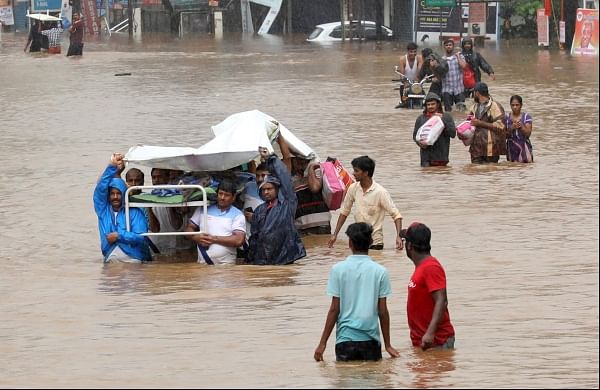Kerala Distress: A Call To Bring Back Humanity!

Kerala popularly known as “God’s own country” in India has left people amazed and devastated economically, emotionally, politically, geographically, and socially by its heavy rainfall this year. This was mainly compared to the last challenging severe Kerala flood in 1924, where monsoons attacked the state with 3,368 mm of rain. During that time, over 1000 people lost their lives leaving other enormous tolls on livestock lives too. Again, this year, heavy rainfall of 2,086 mm, but still 30% above the annual average made life miserable for both humans and other livestock.
This year the devastating flood attached many Indian states like Nagaland and Assam but Kerala faced the overwhelming flood condition. According to the report, more than 400 people lost their lives, more than 800,000 people were displaced, thousands of people became homeless, and the state incurred a loss of around $3 billion (Rs. 21,043 crores). But, as the situation turned worse, people from every nook and corner came together to join hands to help Kerala from the curse of the flood.
Aftermath the flood people are now suffering an end number of health diseases like water-borne diseases, dehydration, malaria, typhoid, etc. However, gradually the situation is turning better and controlled even though thousands of livestock are struggling with the effect outcome. However, many stories and debates come up in the forefront, and found that “Even today, Humanity is still alive!” And when a problem knocks on the door, people from each corner awake and come together to act as saviours to fight the distress together.
Remarkable Contribution and togetherness!
Irrespective of financial condition, status, or prestige each and every people in the country and the world around was moved by the devastating flood condition. What was noteworthy in this situation is that; Indian businesses, Politicians, Bollywood, social networking sites, entrepreneurs, other officials, and most importantly the common people contributed financially, intellectually, and physically to fight against natural disasters. All the people started formulating and planning innovative ways to help Kerala's ‘God's Own Country’ from turning into a graveyard.
Numerous Aid agencies and governments set up more than 4,000 relief camps, while others were rescuing people in submerged villages in helicopters and boats, bringing all necessary goods and supplies, and arranging the best possible required in such a situation. The state received helping hands and relief funds from almost all states and the central government. The United Arabs Emirates designed a national emergency committee to offer help to flood-affected victims.
The Indian Navy, Indian Army, Kerala Police, Indian Airforce, Fire Services, a local fisherman, Kerala Rescue, and other state and private rescue missionaries worked day and night to make the situation better and carried out rescue operations in the state. In a real sense, they set the example of unsung heroes battling again devastating floods in Kerala contributing hand in hand from different parts of the state. On average, they rescued more than ten thousand lives from the high-risk disaster zone.
Ruling Brands and the media world too came together to spread awareness and insist on support through the medium of social networking sites. A number of Bollywood stars also urged their fans to contribute to the Chief Minister Relief Funds. Sonali Bendre who was fighting high-grade cancer in New York also asked people to come forward to donate. Some of them reached the location with contributions and others contributed via donations towards the Chief Minister’s Distress Relief Fund (CMDRF).
Social media giants like Facebook added the Crisis Response feature, which permits people to search and offer support for flood victim states like medical support, food, and donation. Another giant organization Google launched a feature called Plus Code, which allowed people to generate a six or seven-character code where people shared SMS or voice call with rescue workers. Online transaction sites like PAYTM and PHONE PE also added a feature called ‘Donation for Kerala’ or ‘Give a donation to Kerala’ where the user was allowed to directly donate from the Android App. Star India also collaborated with an NGO called Goonj for supplying all the essential requirements in such a situation.
Tamil Nadu IAS officers also promised a day’s salary towards the overwhelming flood relief in Kerala. The Islamic Centre committee of India insisted Muslims donate 10 % of the Eid budget to flood victims. A 21-year-old student from Kerala who was trolled for selling fish also donated Rs 1.5 lakh towards the Relief fund that she collected from people for her further studies and looking after her family.
And the most noteworthy contribution was from the common people, may it be poor or rich, they forgot all personal desire, egoism, and greediness and arose in them a sense of love, togetherness, and unity to contribute whatever they could effort in a different way.
What is said to be the main reason for such a flood and natural disaster?
In simple words, weeks of heavy rainfall have triggered dams to open their floodgates, caused landslides in the mountains, and flooded the coastal regions of Kerala. Poor or insufficient drainage capacity, unplanned reservoir parameters, and failure of flood control arrangements
However, different studies and reports say that climate change, deforestation, and blocking the dams with plastic and garbage were the main causes of making the condition worse. Another reason that was soil and rocks led to this flood and insensitive use of land. Landslips and heavy floods occurred in some areas that witnessed widespread human intrusions. Some other causes for its helpless situation were geographical, illegal repurposing of forests, quarrying, high-rise building constructions, and mining which were man-made, controllable factors that were basically not focused on by people and government.
What Next?
Floods during the monsoon season are very common in most parts of the Indian State, especially in the coastal states. Uttar Pradesh, Assam, and Bihar experienced bad monsoons and saw the worst of it in the disastrous floods last year that affected over more than 40 million people, according to the report. And this year it was Kerala and Nagaland. In the meanwhile, water levels in Kerala have slowly withdrawn. Once the floods and ferocity recede, there are evidently learning lessons for authorities and people to take away from this disaster or any natural calamities. Therefore, instead of expending crores of rupees on unnecessary services, all the state government and central governments must focus on building a high-class drainage system attached with a penalty for those who try to litter the drainage with garbage and plastic. Also, make sure of cleaning it regularly to fight such heavy rain during the monsoon. Here, people must play a vital role in keeping the prevent blockage of drainage and also concentrate on other flood-causing prevention.
Conclusion
And that Hoping for a better life is not in vain as there are people who still believe in Humanity, not just only for humans but also for flora and fauna too. People from both national and international countries came rushing in to work shoulder-shoulders to rescue and lend a hand of relief to all those recently affected states by Global Climate Change, natural calamities, and to some extent, man-made factors too. Now, we can only hope that there won’t be the next time again as such as this (the wild flood)! But as we all know that these things are inevitable and so predictable, we can only take safety measures so as to survive another next flood! Yes, we can plan ahead! People should follow and do exactly as the instructions of the before, during, and after flood safety rules imply to avoid and protect themselves and their families from such a big life-threatening calamity!


 By
By
leave a comment